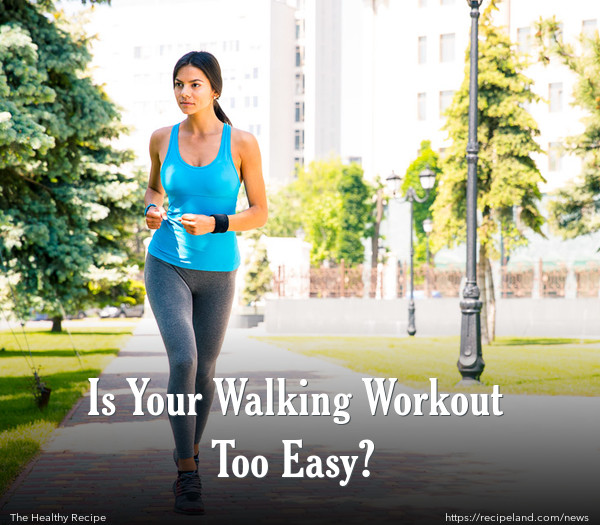It’s no surprise that walking is the most popular type of exercise in the world. Just about anyone can do it, there is little special equipment required, and you can do it just about anywhere and anytime.
A recent study showed that walkers who were able to burn the same number of calories as runners experienced the same cardiovascular benefits, the same lowering of blood pressure, and the same decrease in risk of high cholesterol and diabetes. The key is to make sure that your walking workout is giving you the benefits you need.
Judy Kuan, a New York City-based personal trainer and yoga instructor, explains the importance of pushing yourself to get a great workout. Sure, it’s nice to stroll through the park with a friend, and that does burn more calories than going out for breakfast, but you need to make sure your workout is strenuous enough if you are going to consider it adequate exercise for the day.
Kuan explains, “In order to get the optimal physical and mental benefits from your walking workout, it’s important to maximize the time you spend walking. That doesn’t mean pushing yourself so hard that you get injured.” She describes several simple ways that you can tell that your workout may be too easy, and if you notice these signs, then you may want to kick things up a bit in terms of intensity.
1. You don’t break a sweat.
If you don’t really need a fresh shirt after your walk, or don’t feel the need to wipe your face, then you are probably not working at the proper level—which is 75-80% of your maximum heart rate. This is the range that puts you in the ideal aerobic zone. Kuan states, “Ideally, you want to be in this zone for at least 10-15 minutes during a 30-minute walk for the optimal health benefits.” At this pace, you will feel like you are working at about a 6 or 7 out of a scale of 10 for exertion. You should be breathing hard. This level of workout, combined with a healthy diet, will help you to lose weight.
If you are not reaching this level, then you want to pick up your pace. If walking outside doesn’t do the trick, head for the treadmill. This will help you practice how fast you need to be walking to break a sweat. Kuan said, “Many of my clients find that they can stick to a consistent 3.8 miles per hour or more on the treadmill, and it takes walking for a little while at 2.5 miles per hour to realize that that’s their go-to pace when they walk outside.”
2. You’re chatting too much with your walking buddy.
Taking a walk every day is a great way for some people to multitask. When you walk with your partner or a good friend, it’s an excellent way to socialize and catch up while getting some exercise and fresh air. But, if you can easily carry on a conversation, then you are probably not pushing yourself hard enough.
A personal trainer from Los Angeles, Sarah Ann Kelly, states, “While it’s fun to walk with a buddy, you shouldn’t be able to keep a conversation going comfortably.” To fix the problem, try adding intervals to your walking workout. Pick up the pace for one out of every 3 minutes during the walk. You won’t be able to chat during the faster intervals.
This is not only a great way to burn more calories, but it helps you stay focused on the workout, and less so on the conversation. Kelly suggests, “To make intervals easy, use benchmarks along your route—for example, a mailbox, stop sign, or lamppost ahead of you—and alternate increasing and decreasing your speed between these points.”
3. You’re not seeing any results.
Hitting a weight loss plateau is very frustrating. Instead of getting more discouraged, try changing your diet and exercise routines. Kelly states, “Plateaus happen. In fact, they usually mean you’re on the right path.” If you want to kick start your body, try breaking your walk up into two parts, once early in the day, and once later on.
Kelly explains the benefits, “By getting your heart rate up at two different times in one day, you’ll extend the calorie-burning benefits.” Kuan adds, “Oftentimes, my clients will walk for an hour in the morning and then give themselves carte blanche to eat anything they want because they’ve already worked out.” When you spread out your workouts, you spread your eating, too, which can help keep things under control.
4. You don’t feel tired or sore after your walk.
You should feel at least a little fatigued after your walking workout. If not, you need to push yourself harder. Kuan states, “Even flat walks should have you feeling tired when you’re finished.”
Also, don’t fool yourself into thinking that your lack of fatigue means you are in great shape. Kelly adds, “I get that it can feel really good when the workout routines you’ve created start to feel easy. But it’s crucial to remember that when this is the case, you’re not going to get the best results.” You need to push yourself a little harder. One way to do this is by adding some hills to your workout. When you walk uphill, you will be firing different muscles in your calves, hamstrings, and glutes.
Kuan explains, “As these muscles get stronger, you’ll likely feel a little sore—possibly even during your walking workout. If you have an injury or are afraid to boost your speed, walking uphill can get your heart rate up—minus the need for speed.”










Comments